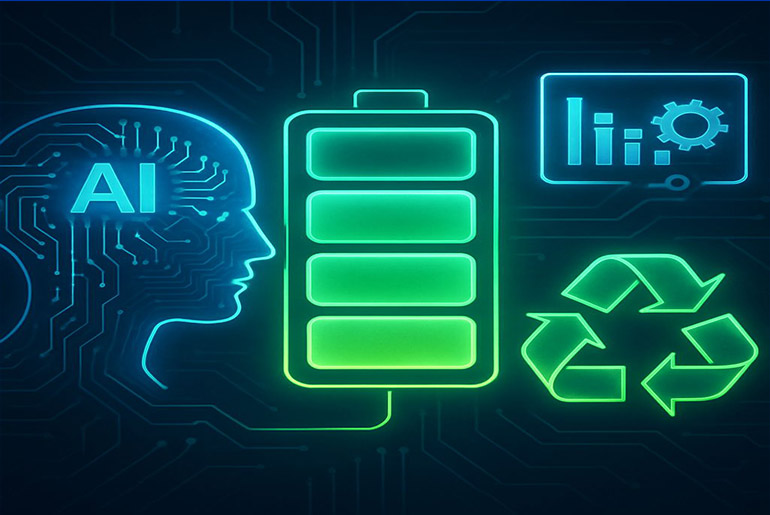The battery industry has quickly changed from being a supporting technology to becoming the very foundation of sustainable growth as the world moves toward electrification. Artificial Intelligence (AI) is currently transforming every stage of the battery value chain as gigafactories proliferate around the world and energy storage goals increase. AI is not only improving performance but also influencing the direction of energy in general, from research and development (R&D) to battery management systems (BMS) and recycling.
While exact figures for AI’s role in battery technology remain scattered across industry reports, analysts agree that AI-driven solutions in the battery sector are expected to grow exponentially this decade, aligning with the broader AI in the energy market, which is projected to grow from USD 8.91 billion in 2024 to USD 58.66 billion by 2030.
Smart Chemistry: Accelerating Battery R&D
The journey to a next-gen battery begins in the lab. Traditionally, it takes years of trial and error to develop a new chemistry, but AI is changing that paradigm. Machine learning algorithms can analyze hundreds of thousands of chemicals in a matter of minutes, discovering promising sets of materials far more quickly than human scientists are able to do.
For example, Argonne National Laboratory and the Toyota Research Institute used deep learning to cut the number of experiments needed in their battery project by almost 70%, and half the time on the total development.
Global spending on AI-enabled battery R&D is expected to touch USD 5.1 billion by 2030, up from USD 0.5 billion in 2023.
AI in Battery Management Systems (BMS): Smarter, Safer, Stronger
AI-integrated BMS are the brain of modern batteries. They go far beyond traditional monitoring—predicting failures, optimizing charge/discharge cycles, and extending battery life.
McKinsey’s intelligent BMS with predictive algorithms can increase battery life by 25% and reduce warranty costs by 30%. These systems use neural networks to dynamically balance operating conditions based on load demand, historical usage, ambient temperature, and real-time information.
Global revenue from AI-based BMS is forecast to rise from USD 0.7 billion in 2023 to USD 9 billion by 2030, making it one of the most lucrative sub-segments.
Closing the Loop: AI in Battery Recycling
With the total number of end-of-life batteries on the rise, artificial intelligence is starting to make a difference in the recycling arena. Firms like Attero, Redwood Materials, and Li-Cycle are starting to employ AI for material identification, robotic disassembly, and process flow improvements.
Attero, for example, uses a deep learning machine learning model that can classify black mass components with 98.6% accuracy, significantly boosting material recovery efficiency. AI-based sorting systems can improve throughput by over 40% and lower contamination levels.
By moving from USD 0.2 billion in 2023, it is estimated that by 2030 the financial impact of Artificial Intelligence upon battery recycling will scale to USD 5 billion.
Challenges & Road Ahead
Promising as it is, applying AI to the battery system is also by no means a cakewalk. “Data silos, model interpretability, cybersecurity and absence of standardized datasets are some of the fundamental problems. It is essential there is collaboration between academia, startups, and OEMs to fill the gaps.
But, governments and private sector are spending billions to bridge these obstacles. For example, the U.S. Department of Energy’s Battery500 Consortium, the EU’s Battery Passport initiative, and India’s National Programme on AI are merely a few examples of how AI is being embedded into policy frameworks.
India in Focus: A Rising AI Powerhouse
India is witnessing a rapid surge in the EV and Battery Sector and resulting in recognizing AI’s transformative potential. Amara Raja, Tata Chemicals and Log9 Materials are exploring AI applications for various purposes including second- life battery assessment, thermal management and recycling logistics.
A 2024 NITI Aayog report estimates that integrating AI across India’s battery supply chain can unlock USD 12 billion in economic value by 2030.
AI isn’t just a digital layer in the battery story; it’s becoming the story. As energy demands rise, sustainability goals tighten, and innovation cycles shorten, AI will be the linchpin in realizing the full potential of electrification.
With scalable breakthroughs, real-time intelligence, and circular economy integrations, the AI-battery convergence is setting the stage for an electrified, intelligent, and sustainable future.



